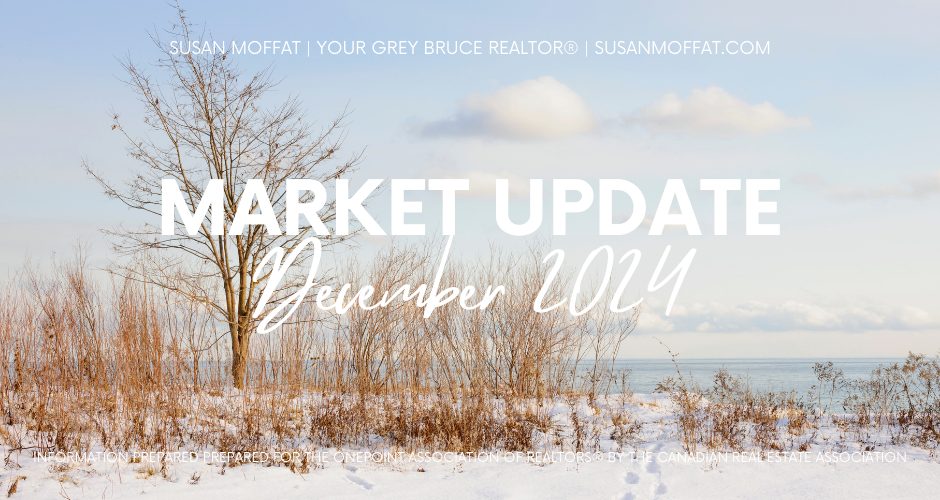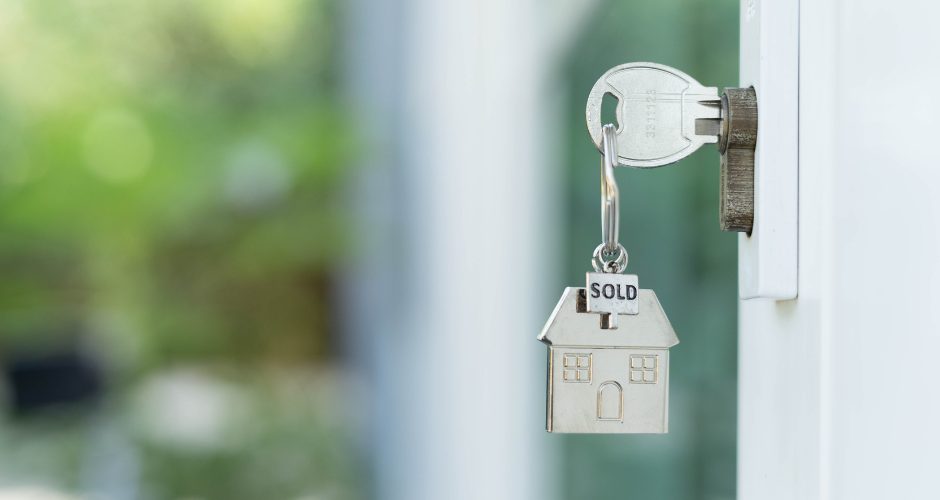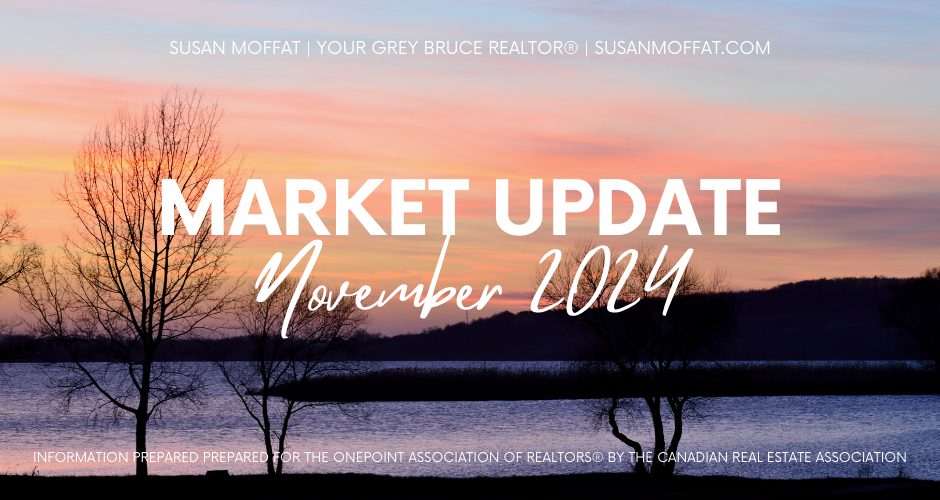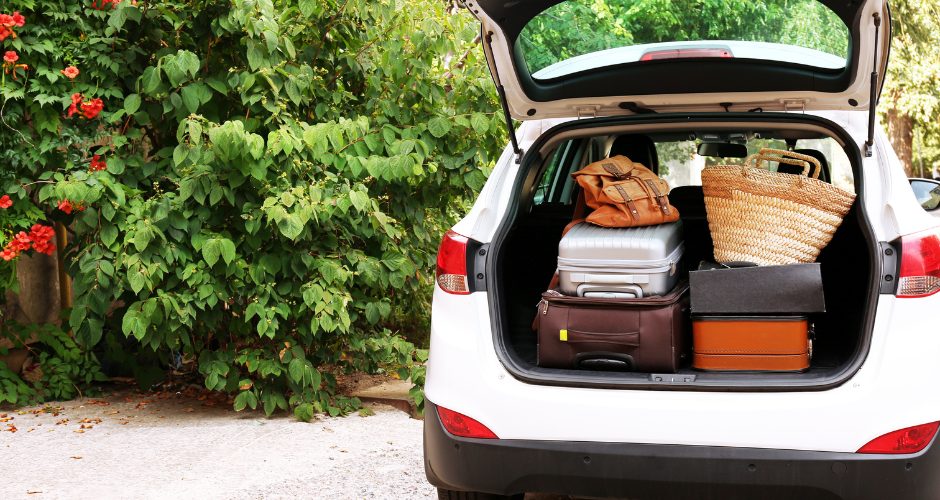Social Links Widget
Click here to edit the Social Media Links settings. This text will not be visible on the front end.
December 2024 Real Estate Market Update

Board & Association Information
OnePoint Association of REALTORS® serves as a unified body representing almost 3,000 real estate professionals across the regions of Huron, Perth, Grey, Bruce, Wellington, Georgian Bay, Simcoe, Parry Sound, Haliburton and Muskoka.
Related: November 2024 Real Estate Market Update
*IMPORTANT: Due to the transition, December data is not 100% accurate as some members had to relist their listings in PropTx which could appear as ‘new’.
Wondering how these numbers might impact your real estate plans? Whether you’re buying, selling, or just curious about market trends, I’ve got you covered! Let’s navigate the market together! Contact me for a complimentary, no-obligation property valuation!
For more information, contact:
Susan Moffat, REALTOR® with Century 21 In-Studio Realty Inc., Brokerage
519.377.5154
susan.moffat@c21.ca
Bringing Nature Indoors: The Incredible Benefits of Houseplants

Houseplants are more than just decorative elements in our homes; they are vital contributors to our mental and physical well-being. As we navigate our busy lives, bringing a bit of nature indoors can provide numerous benefits that enhance our daily experiences. Here’s a closer look at why incorporating houseplants into your living space is a smart choice.
Stress Reduction and Emotional Well-being
Houseplants are powerful stress-busters. In a fascinating study, researchers compared participants performing two different tasks: transplanting a houseplant versus completing a computer task. The results were striking – those working with plants experienced a significant decrease in blood pressure and felt more comfortable and soothed. Experts like Melinda Knuth, a horticultural science professor, note that being around plants can actually reduce cortisol levels, our primary stress hormone.
Boosting Productivity and Attention
The benefits of houseplants extend beyond emotional wellness. Research demonstrates that plants can dramatically improve workplace and learning environments. In one study, college students working in a lab with plants completed tasks 12 percent faster and experienced reduced stress. For children, the impact is even more profound – elementary students in classrooms with real plants showed improved concentration and attention in brain scans.
Enhancing Happiness and Life Satisfaction
Perhaps most compelling is plants’ ability to elevate mood. An experiment revealed that individuals spending just 5-10 minutes in a room with houseplants reported higher happiness levels compared to those in plant-free spaces. Interestingly, purple and green plants were particularly effective at reducing negative emotions.
Mental Health and Therapeutic Benefits
Beyond immediate mood improvements, houseplants offer deeper psychological support. During the pandemic, studies showed that people with houseplants experienced fewer symptoms of depression and anxiety. Some medical clinics have even begun “prescribing” plants to patients dealing with mental health challenges.
Practical Considerations
When selecting houseplants, consider low-maintenance options like succulents or cacti, which are perfect for beginners. These plants not only beautify your space but also provide a gentle reminder of self-care and nurturing.
Final Thoughts on the Benefits of Houseplants

By introducing houseplants into your indoor environment, you’re not just decorating – you’re creating a sanctuary that supports your mental and emotional well-being. This winter, let a little green transform your living space into a haven of tranquility and joy.
Looking to buy, sell, or invest? As your REALTOR®, I’ll guide you every step of the way. Contact me today and let’s turn your real estate dreams into reality!
For more information, contact:
Susan Moffat, REALTOR® with Century 21 In-Studio Realty Inc., Brokerage
519.377.5154
susan.moffat@c21.ca
How to Know You’ve Found ‘The One’ in Your Home Search

Recognizing when you’ve found the right home to make an offer on is a crucial step in the home-buying process. It can be an emotional journey filled with excitement and uncertainty, but certain signs can help you confidently determine if a property is “The One.” Here are key indicators to look for as you navigate your house-hunting experience.
You Feel an Immediate Connection
From the moment you walk through the door, you should feel a sense of comfort and belonging. If the house resonates with you emotionally and feels like home, that’s a strong indicator that you may have found the right place. Pay attention to how at ease you feel in the space; if it feels right, it likely is.
The Home Meets Your Criteria
Before starting your search, create a list of your must-haves and nice-to-haves. If the home checks off most of these boxes—such as the number of bedrooms, layout, and location—you’re on the right track. While no home will be perfect, it should align closely with your essential needs.
You Can Envision Your Future There
A significant sign that you’ve found the right home is your ability to imagine your life unfolding within its walls. Whether it’s hosting family gatherings or enjoying quiet evenings, if you can see yourself living there long-term, it’s a promising sign.
It Fits Within Your Budget
Financial considerations are paramount in any home purchase. The right home should comfortably fit within your budget without causing financial strain. This ensures that you can enjoy your new space without ongoing stress about payments.
You Start Thinking About Personal Touches
If you find yourself mentally arranging furniture or imagining how to decorate the space, this is a clear sign of attachment. Visualizing how your belongings will fit into the home indicates that you’re already picturing yourself living there.
You Feel Excited About Making an Offer
When thinking about putting in an offer brings feelings of excitement rather than anxiety, it’s a strong indication that this home might be right for you. This sense of readiness can often outweigh any lingering doubts.
Your Gut Instincts Are Strong
Sometimes, intuition plays a significant role in decision-making. If everything about the home feels right and you can’t stop thinking about it after leaving, trust your gut feelings—they can often guide you toward the right choice.
You’re Ready to Commit
If the thought of making an offer excites you and feels like a natural next step, it’s likely time to act. A sense of commitment and enthusiasm about the property is often a sign that you’ve found “The One”.
You Defend Its Flaws
If friends or family point out flaws in the home but you find yourself passionately defending it, this attachment suggests that you’ve developed a connection that goes beyond mere practicality.
You Want to Stop Looking
If this house has raised the bar so high that nothing else compares, and you’re ready to stop your search altogether, it’s likely time to make an offer. Feeling satisfied with what this home offers can indicate it’s truly the right fit for you.
Final Thoughts on the Home Search

Finding “The One” in real estate is not just about checking boxes; it involves emotional connections and practical considerations. By recognizing these signs during your house hunt, you can confidently make an informed decision with your REALTOR® when it’s time to submit an offer on your dream home. Trust yourself throughout this process—your instincts are valuable guides on this exciting journey!
Looking to buy, sell, or invest? As your REALTOR®, I’ll guide you every step of the way. Contact me today and let’s turn your real estate dreams into reality!
For more information, contact:
Susan Moffat, REALTOR® with Century 21 In-Studio Realty Inc., Brokerage
519.377.5154
susan.moffat@c21.ca
Showcase Grey Bruce: Must-Visit Spots for Your Holiday Guests

Hosting friends and family during the holidays in Grey Bruce, Ontario, can be a delightful experience with the right local recommendations. Here are some top picks to make your gatherings memorable:
Best Place for a Cocktail: Bruce Wine Bar
Bruce Wine Bar in Thornbury is an excellent choice for cocktails. Known for its cozy atmosphere and creative drink menu, this spot offers a delightful selection of local and global wines, as well as expertly crafted cocktails that capture the essence of the season.
Best Place to Take Out-of-Town Guests: Blue Mountain Village
For out-of-town guests, Blue Mountain Village is a must-visit destination. This vibrant area offers a mix of shopping, dining, and outdoor activities, making it perfect for exploring. Guests can enjoy breathtaking views, seasonal events, and a variety of restaurants to choose from.
Best Place for Live Music: Jazzmyns
Jazzmyns in Owen Sound is a stylish venue that combines great food with live music. Known for its creative pub eats and vibrant atmosphere, it frequently hosts local musicians, making it an ideal spot for those looking to enjoy a night out filled with entertainment.
Best Restaurant for Large Groups: Kettles Back Home Cookin’
Kettles Back Home Cookin‘, located in just outside of Chatsworth, is perfect for large gatherings. This family-friendly restaurant is known for its hearty portions and homestyle cooking. With a welcoming atmosphere and a diverse menu featuring all-day breakfast, lunch, and dinner options, it can comfortably accommodate groups looking to enjoy a delicious meal together.
Best Place to Walk Off a Big Meal: Harrison Park
After a hearty holiday meal, take a leisurely stroll through Harrison Park in Owen Sound. This scenic park features beautiful trails along the Sydenham River, providing the perfect setting to enjoy nature.
Best Place for Last-Minute Shopping: Downtown Markdale
For last-minute holiday shopping, downtown Markdale is the place to be. This charming area is filled with shops that include a home decor store, bookstore, toy store, and more. It’s an excellent spot to find unique gifts while supporting local businesses during the festive season.
These local spots will help you create unforgettable holiday memories with your loved ones in Grey Bruce! Follow me on social media @susanmoffatc21 for more local recommendations and real estate updates.
Looking to buy, sell, or invest? As your REALTOR®, I’ll guide you every step of the way. Contact me today and let’s turn your real estate dreams into reality!
For more information, contact:
Susan Moffat, REALTOR® with Century 21 In-Studio Realty Inc., Brokerage
519.377.5154
susan.moffat@c21.ca
Bank of Canada Reduces Policy Rate by 50 Basis Points to 3.25%

The Bank of Canada (BoC) has made a significant move in its final interest rate announcement of 2024, cutting the key policy rate by 50 basis points to 3.25%14. This marks the fifth consecutive rate cut since June, signaling the central bank’s ongoing efforts to stimulate economic growth and maintain inflation near its 2% target.
Key Points of the Announcement
- New Policy Rate: 3.25%, down from 3.75%
Inflation Status: Currently at 2%, matching the Bank of Canada’s target
Economic Context: Q3 GDP growth was 1%, below projections
Labour Market: Unemployment rate rose to 6.8% in November
Impact on the Real Estate Market
This rate cut could have significant implications for the Canadian housing market:
- Mortgage Rates: Variable mortgage rates are expected to fall by 0.5%
Affordability: Lower rates could improve buying power for some homebuyers
Market Activity: The cut may reinvigorate the housing market, potentially leading to increased sales and price growth
What’s Next?
The Bank of Canada’s next interest rate announcement is scheduled for January 29, 202510. Market watchers will be closely monitoring economic indicators and the Federal Reserve’s decisions in the coming weeks to gauge the potential for further rate adjustments.
Final Thoughts on the Bank of Canada’s Decision
While this rate cut from the Bank of Canada aims to boost economic activity, its full impact on the real estate market and broader economy remains to be seen. Prospective homebuyers and investors should stay informed and consider how these changes might affect their plans. As always, consulting with financial and real estate professionals is advisable when making significant decisions in light of these economic shifts.
Read the Press Release.
Whether you’re a homeowner, prospective buyer, or real estate investor, understanding these market changes is crucial. As your trusted REALTOR®, I’m here to help you navigate these shifts and make informed decisions! Call, text, email, or DM me to chat about how this announcement affects your real estate plans!
For more information, contact:
Susan Moffat, REALTOR® with Century 21 In-Studio Realty Inc., Brokerage
519.377.5154
susan.moffat@c21.ca
How to Sweeten an Offer without Raising the Price

In today’s hot real estate market, securing your dream home often requires more than just offering the highest price. While the amount you’re willing to pay is undoubtedly crucial, savvy buyers know that there are several other ways to make their offers more appealing to sellers. Let’s explore some effective strategies to sweeten your offer without necessarily raising the price.
Understand the Seller’s Needs
One of the most powerful ways to strengthen your offer is to align it with the seller’s specific needs and circumstances. For instance, the closing date can be a significant factor for many sellers. If they’re relocating for work or have already purchased another property, flexibility on the closing date could be extremely attractive. By accommodating their preferred timeline, you’re offering a valuable benefit that goes beyond just the sale price.
Demonstrate Financial Readiness
Sellers want assurance that the sale will go through smoothly. One of the best ways to provide this peace of mind is by having your finances in order. Consider these steps:
- Obtain a Pre-Approval Letter: Having a pre-arranged mortgage certificate attached to your offer shows the seller that you’re a serious buyer with the means to follow through on the purchase.
- Increase Your Earnest Money Deposit: A larger earnest purchase deposit can demonstrate your commitment to the transaction.
Offer Additional Incentives
Think creatively about what else you can bring to the table:
- Waive Certain Contingencies: While this should be done cautiously, waiving or limiting certain contingencies can make your offer more appealing. Always consult with your REALTOR® before taking this step.
- Minimal Conditions: The fewer conditions attached to your offer, the more appealing it becomes.
- Personal Touch: Consider including a personal letter explaining why you love the home. While this won’t override financial considerations, it can help your offer stand out in a close competition.
Final Thoughts

Remember, in a competitive market, it’s not always about offering the highest price. By understanding and addressing the seller’s needs, demonstrating your financial readiness, and offering attractive terms, you can make your offer stand out even if it’s not the highest bid on the table. Always work closely with your REALTOR® to craft the most compelling offer possible for your specific situation.
Looking to buy, sell, or invest? As your REALTOR®, I’ll guide you every step of the way. Contact me today and let’s turn your real estate dreams into reality!
For more information, contact:
Susan Moffat, REALTOR® with Century 21 In-Studio Realty Inc., Brokerage
519.377.5154
susan.moffat@c21.ca
November 2024 Real Estate Market Update

OnePoint Association of REALTORS® – Grey Bruce and Owen Sound MLS® home sales rocket up to above-average levels in November.
The number of homes sold in Grey Bruce and Owen Sound via the MLS® System of the OnePoint Association of REALTORS® totaled 228 units in November 2024. This was an advance of 43.4% from November 2023. Home sales were 10.1% above the five-year average and 4.7% above the 10-year average for the month of November. On a year-to-date basis, home sales totaled 2,452 units over the first 11 months of the year. This was up by 6.1% from the same period in 2023.
“Sales activity shot up in November with an unexpected strength, putting us back above typical levels for this time of year,” said Bonnie Looby, President of the OnePoint Association of REALTORS®. “With interest rates gradually winding down we knew that buyers would come back to the market, but we weren’t anticipating this kind of rush so soon. There could be a sense of FOMO among younger first-timers, or keen buyers who are trying to get in before the combination of mortgage regulation changes and further interest rate cuts spur even more competition for demand. In any case, our market is looking very active as we head into what is usually a quieter time of year.”
The MLS® Home Price Index (HPI) tracks price trends far more accurately than is possible using average or median price measures. The overall MLS® HPI composite benchmark price was $563,900 in November 2024, down only 0.2% compared to November 2023.
The benchmark price for single-family homes was $572,100, nearly unchanged, down only 0.2% on a year-over-year basis in November. By comparison, the benchmark price for townhouse/row units was $479,900, a minor decrease of 2.9% compared to a year earlier, while the benchmark apartment price was $370,400, a slight gain of 0.9% from year-ago levels.
The average price of homes sold in November 2024 was $668,026, a minor increase of 1.4% from November 2023. The more comprehensive year-to-date average price was $646,786, a small gain of 1.5% from the first 11 months of 2023. The dollar value of all home sales in November 2024 was $152.3 million, a substantial gain of 45.3% from the same month in 2023.
The number of new listings saw a modest gain of 3.1% (10 listings) from November 2023. There were 334 new residential listings in November 2024. This was the largest number of new listings added in the month of November in more than a decade. New listings were 15.7% above the five-year average and 28.7% above the 10-year average for the month of November.
Active residential listings numbered 1,168 units on the market at the end of November, up modestly by 3.7% from the end of November 2023. Active listings haven’t been this high in the month of November in more than five years. Active listings were 43.2% above the five-year average and 27.3% above the 10-year average for the month of November.
Months of inventory numbered 5.1 at the end of November 2024, down from the 7.1 months recorded at the end of November 2023 and above the long-run average of 4.5 months for this time of year. The number of months of inventory is the number of months it would take to sell current inventories at the current rate of sales activity.

(1) Sales / new listings * 100; compared to levels from previous periods. (2) Active listings at month end / monthly sales; compared to levels from previous periods. (3) Sale price / list price * 100; average for all homes sold in the current month.
Board & Association Information
OnePoint Association of REALTORS® serves as a unified body representing almost 3,000 real estate professionals across the regions of Huron, Perth, Grey, Bruce, Wellington, Georgian Bay, Simcoe, Parry Sound, Haliburton and Muskoka.
Related: October 2024 Real Estate Market Update
Wondering how these numbers might impact your real estate plans? Whether you’re buying, selling, or just curious about market trends, I’ve got you covered! Let’s navigate the market together! Contact me for a complimentary, no-obligation property valuation!
For more information, contact:
Susan Moffat, REALTOR® with Century 21 In-Studio Realty Inc., Brokerage
519.377.5154
susan.moffat@c21.ca
Travel Smart: Keeping Your Home Safe While You’re Away

Planning a vacation is exciting, but keeping your home safe while you’re away is crucial. Here are essential home security tips to help protect your property during your time off.
Lock Everything Up
Before leaving, double-check that all doors and windows are securely locked. Don’t forget about garage doors, pet doors, and any accessible ground-level entry points. For added security, consider disconnecting electronic garage door openers to prevent unauthorized access.
Invest in a Security System
A robust home security system can deter potential burglars and provide peace of mind. Look for systems that include features like motion detectors, surveillance cameras, and smart locks that can be monitored remotely. This way, you can keep an eye on your home from anywhere
Make Your Home Look Occupied
To give the impression that someone is home, leave a few lights on or set them on timers. Additionally, consider using smart plugs to control electronics like TVs or radios remotely. A parked car in the driveway can also enhance this effect.
Suspend Mail and Newspaper Deliveries
An overflowing mailbox or a pile of newspapers signals to burglars that you’re away. To prevent this, either ask a trusted neighbour to collect your mail or contact the post office and newspaper service to hold deliveries until you return.
Keep Valuables Out of Sight
Store valuable items like jewelry and electronics in a safe or lockbox, preferably out of sight from windows. This reduces the temptation for thieves looking for easy targets.
Be Mindful of Social Media
Avoid posting about your vacation plans on social media until after you return. Broadcasting your absence can attract unwanted attention from potential burglars.
Use Timers for Outdoor Lights
Install motion-sensor lights around your property or use timers for outdoor lighting to create the illusion of activity when it gets dark. This can deter intruders who prefer to operate under the cover of darkness.
Ask for Help
Enlist friends or neighbours to check on your home periodically while you’re away. They can collect mail, water plants, and maintain the appearance of occupancy, which is a strong deterrent against break-ins.
Hire a House Sitter
If you’re particularly concerned about security, consider hiring a house sitter who can live in your home while you’re away. This option provides continuous oversight and care for pets and plants.
Review Your Insurance Policy
Before you leave, ensure your homeowner’s insurance policy is up-to-date and covers theft or damage adequately. This preparation will provide additional peace of mind while you’re away.
Final Thoughts on Keeping Your Home Safe While You’re Away

By following these tips, you can enjoy your vacation knowing that you’ve taken proactive steps to secure your home against potential threats. Finally, experts recommend creating a home security checklist, so you don’t forget anything. That alone will give you peace-of-mind. Safe travels!
Looking to buy, sell, or invest? As your REALTOR®, I’ll guide you every step of the way. Contact me today and let’s turn your real estate dreams into reality!
For more information, contact:
Susan Moffat, REALTOR® with Century 21 In-Studio Realty Inc., Brokerage
519.377.5154
susan.moffat@c21.ca
Questions Every Buyer Should Ask at an Open House

Attending an open house can be an exciting experience, but it’s easy to get caught up in the moment and forget to ask crucial questions about the property. As your trusted Grey Bruce REALTOR®, I want to ensure you’re fully prepared to make an informed decision. Here are some essential questions that buyers often overlook during open houses:
Property Specifics
- Age and Condition of Major Components
- How old is the roof?
- What’s the age of the furnace, air conditioner, and other HVAC equipment?
These questions can give you insight into potential future expenses and the overall condition of the home’s critical systems.
Included Items
- What inclusions and exclusions are there?
Be specific about kitchen appliances, gas-connected BBQs, chandeliers, and window coverings. Knowing what stays and what goes can help you budget for any necessary purchases after moving in.
Neighbourhood and Location
- How does the price compare to similar properties in the neighbourhood?
- What are the key features of the neighbourhood?
Understanding the property’s value relative to the local market is crucial for making a competitive offer. Ask about amenities, safety, traffic patterns, access to public transit, and property turnover rates. These factors can significantly impact your daily life and the property’s long-term value.
Potential Issues
- Are there any potential obstacles to the sale? Inquire about tenants, outstanding liens, or other factors that could complicate or delay the purchasing process.
- Are there any outstanding maintenance issues or necessary repairs? Look for things like cracked tiles, leaky faucets, or other visible problems that might need addressing.
Property Use Limitations
- Are there any issues that impact the full use of the property? Ask specifically about shared driveways or walkways, public “right of way” through the property, and water drainage rights from neighbouring homes.
Final Thoughts

Remember, an open house can feel hectic, especially if it’s a property you love. You might feel pressured to make an offer quickly, but it’s crucial to take your time, ask the right questions, and consider your decision carefully. You don’t want to discover important details after it’s too late.
As your REALTOR®, I’m here to help you navigate these questions and ensure you have all the information you need to make the best decision. Don’t hesitate to reach out if you need assistance during your home search or have any questions about the buying process. Happy house hunting!
Looking to buy, sell, or invest? As your REALTOR®, I’ll guide you every step of the way. Contact me today and let’s turn your real estate dreams into reality!
For more information, contact:
Susan Moffat, REALTOR® with Century 21 In-Studio Realty Inc., Brokerage
519.377.5154
susan.moffat@c21.ca
Selling Your Home During the Holiday Season: Expert Tips from a REALTOR®

As a REALTOR®, I understand that selling your home during the holiday season can present unique challenges and opportunities. While many homeowners may hesitate to list their properties during this festive time, there are numerous advantages to doing so. Motivated buyers are actively searching for homes, and with the right strategies, you can ensure your listing stands out. Here are my top tips for successfully listing your home during the holidays.
Partner with an Experienced REALTOR®
Choosing the right real estate agent is crucial, especially during the holiday season. An experienced REALTOR® like me can provide valuable market insights and tailored strategies to attract buyers. I will work closely with you to create a customized marketing plan that highlights your home’s best features while navigating the seasonal market dynamics.
Set a Competitive Price
Pricing your home correctly is essential for attracting serious buyers. During the holidays, competition may be lower, which means a well-priced home can stand out significantly. I will conduct a thorough market analysis to help you set a competitive price that reflects current trends while maximizing your return.
Enhance Curb Appeal
First impressions matter, especially in winter when landscapes can appear stark. Make sure your home’s exterior is well-maintained by clearing walkways of snow and debris and ensuring that landscaping is tidy. Adding tasteful holiday decorations can create an inviting atmosphere without overwhelming potential buyers.
Decorate with Care
While it’s tempting to go all out with holiday decor, it’s important to keep it simple and neutral. I recommend using elegant decorations that enhance your home’s features rather than distract from them. This approach allows potential buyers to envision their own holiday celebrations in the space.
Create a Warm and Inviting Atmosphere
During showings, aim to create a cozy environment that makes buyers feel at home. Consider lighting a fire in the fireplace, playing soft music, or baking cookies. These small touches can leave a lasting impression on potential buyers.
Invest in Professional Photography
High-quality photos are essential for online listings, especially during the holidays when many buyers begin their search digitally. I work with professional photographers who can capture your home’s essence and highlight its festive charm while maintaining its appeal year-round.
Utilize Virtual Tours
In today’s digital age, many buyers prefer virtual tours over in-person visits—especially during the busy holiday season. I can help create engaging video tours that allow potential buyers to explore your home from the comfort of their own devices, increasing interest even when foot traffic is lower.
Be Flexible with Showings
Understanding that potential buyers have busy schedules filled with holiday activities is key to securing showings. I encourage flexibility in scheduling appointments, including evenings and weekends, to accommodate their needs and increase your chances of attracting serious interest.
Highlight Seasonal Features
If your home boasts features that shine in winter—like a cozy fireplace or energy-efficient heating—make sure these are emphasized in your listings and during showings. Highlighting these aspects can enhance your home’s appeal and justify a stronger price point.
Stay Positive and Patient
Finally, remember that selling during the holidays may take time, but staying positive and patient is essential. The right buyer may come along when you least expect it, so trust the process and lean on my expertise as we navigate this unique selling season together.
Final Thoughts on Listing During the Holiday Season

By implementing these strategies, you can effectively market your home during the holiday season while creating an inviting atmosphere that resonates with potential buyers. If you’re ready to list your home or have any questions about the selling process, don’t hesitate to reach out for a complimentary, no-obligation property valuation!
Looking to buy, sell, or invest? As your REALTOR®, I’ll guide you every step of the way. Contact me today and let’s turn your real estate dreams into reality!
For more information, contact:
Susan Moffat, REALTOR® with Century 21 In-Studio Realty Inc., Brokerage
519.377.5154
susan.moffat@c21.ca

 Facebook
Facebook
 X
X
 Pinterest
Pinterest
 Copy Link
Copy Link

